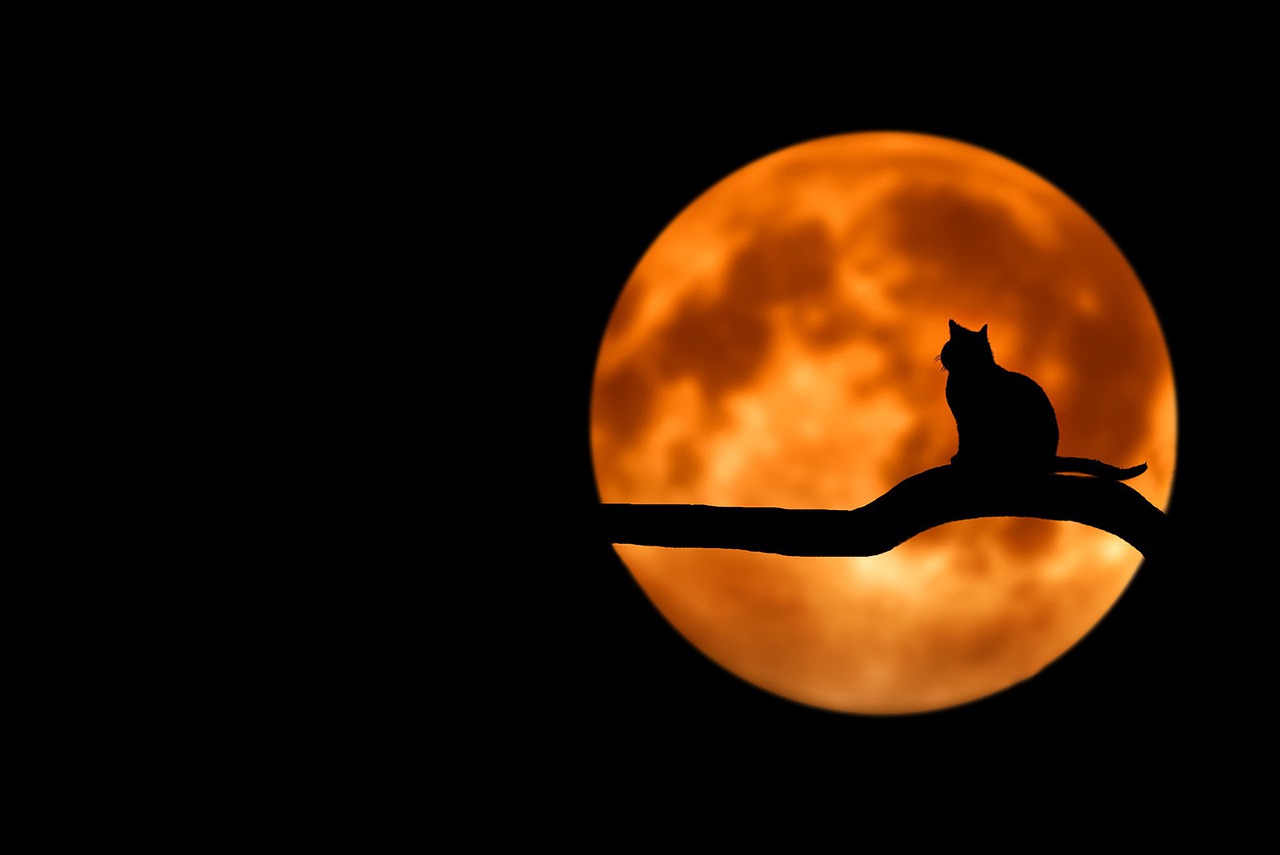 uper-spies James Bond and Austin Powers don’t have cats. Neither does rogue operative, Jason Bourne. But some of their adversaries do. In fact, the picture of a white Persian cat in Bond villain Ernst Blofeld’s lap is an indelible cultural image, as is that of the hairless cat that Dr. Evil cradles in the Austin Powers franchise.
uper-spies James Bond and Austin Powers don’t have cats. Neither does rogue operative, Jason Bourne. But some of their adversaries do. In fact, the picture of a white Persian cat in Bond villain Ernst Blofeld’s lap is an indelible cultural image, as is that of the hairless cat that Dr. Evil cradles in the Austin Powers franchise.
If these furry creatures’ association with fictitious international criminals isn’t enough, cats also have been linked to witchcraft: In the Middle Ages, women who owned black cats came under suspicion as did the cats, who were assumed to be witches in disguise — and were burned at the stake. During this period, ‘cat-burning’ was considered to bring good luck.
Cats persist as a symbol of evil
It’s funny thinking about cats as the symbol of evil.
A quick Internet search brings up a series of articles, including one on the 13 reasons why cats are just plain evil. (I’ve decided not the repost the link here). Interestingly enough, the author of the article writes that one reason cats are evil is that they “are the favored pets of witches.” Actually, witches — both modern ones and the one who were burned at the stake during Middle Ages — owned cats because being close to nature is central to their religious beliefs.
But how did cats become to be seen as evil?
Ancient Egyptians revered cats
Cats were beloved by Egyptians. Purina, the multinational firm known for making cat chow, notes that
“Egyptians have had a long love affair with cats. Not only were they a source of companionship — they were also a status symbol and source of worship.”
“Egyptians have had a long love affair with cats. Not only were they a source of companionship — they were also a status symbol and source of worship.” — Purina
I’m definitely tracking the cat ‘worship’ concept. While I don’t have any cats — my allergist says owning a cat for me is worse for my lungs than chain smoking — I’ve long revered cats. In my home, I use cat statuettes as bookends, and have various other representations of these felines throughout my home. I’m on the fence about getting an electronic cat that responds to touch (i.e., purring, meowing and flicking its robotic tail) — but I can see why Egyptians of antiquity fell in love with cats.
Much like modern-day Chicago, Egypt had a rat problem. Apparently snakes and scorpions were threats too. Enter the ancestors of Garfield the Cat. Over many centuries, Egyptians found that a cat was the one creature that could make the world safe, according to Purina.
In an era when unknown phenomena seemed like they could only be explained by powerful deities, it seemed only natural to the Egyptians to worship kitty cats. The Sphinx being the most obvious representation of their reverence of cats, Egyptians also covered their walls with images of regal-looking cats and made fine statues of them too.
Peruvian love affair with cats?
Ancient Peruvians may have been attracted to cats in a way similar to Egyptians.
Nazca, a culture that lived in what is now Peru, etched a 37-meter-long geoglyph of a cat in the coast plain — some 2,000 years ago. Though the Nazca Lines themselves weren’t discovered until 1926, when air travel started to become common, it’s been a World Heritage site since 1994, and is famous for its humming bird and astronaut geoglyphs. Yes, I did say an astronaut that looks suspiciously like Neil Armstrong was carved in the face of the earth two millennia ago.
The Nazca cat geoglyph was only discovered last October. If the Nazca thought enough of cats to etch a 37-meter geoglyph of one into the mountain that persists 2,000 years later, they must have thought highly of them. According to Smithsonian Magazine, the Nazca geoglyphs may have been used for astrological, calendrical purposes as well as religious rituals to encourage rainfall and fertility. Others posit that the smaller geoglyphs were used as location markers for travelers.
To think that all this fuss is over cats. (To be fair, the cat is only one of more than 300 figures the Nazca created — almost half which have been discovered in the last five years).
Cats are seen as marker of femininity
Fast-forward to 2022.
A quick Google search shows that a feline femme fatale cat mask is conveniently available on Amazon for only $25.22. But the association between cats and gender is not a new one. In 2019, ‘Profs and Pints,’ an organization that was founded to “democratize higher learning,” hosted an event that was designed to demystify the “magical, spiritual and even sexual” depictions of cats in media and society.
I was among the attendees of this event, and can attest that it was a doozy. As I learned at the Profs and Pints event, cats persist as a marker of femininity in the media and our language of pop culture.
But still, cultural images of cats being a marker of femininity didn’t sprout from Vogue, any more than the idea that cats are plain evil stem from Sports Illustrated.
Church edicts declare war on cats
To understand why suspicions of cats persist, you need to go back to the 13th Century, when Pope Gregory IX had a definite opinion of cats — and it wasn’t a positive one. According to Pope Gregory IX, cats were the embodiment of the devil himself. In those days, papal inquisitors extracted confessions from prisoners that they worshiped the devil and his black cat by torturing them vigorously.
Based on these confessions, in 1233 Pope Gregory IX issued an official papal decree declaring that Satan was half-cat and sometimes took the form of cat. As one might have predicted, thereafter, mass slaughters of cats blanked Europe. Cats were later blamed for the Black Death (1346–1352), though rats were actually the culprit. In other words, the Europeans were murdering their best ally in the war against the pandemic.
And in the 13th Century, people in medieval Ypres, Belgium, had a festival called Kattenstoet, where they’d throw cats from the belfry tower to symbolize the killing evil spirts. (As a side note, the festival continues in modern Belgium — but now Kattenstoet honors felines with a parade that features cute effigies of cats, but I digress.)
Then, in 1484, another pope, Innocent VIII, issued a papal bull that condemned to death all cats and their human companions. Thus, purported heretics, such as the Cathars and Waldensians, were accused of worshipping cats, according to Medievalists.net. Which brings us back to Pope Innocent VIII’s 1484 declaration that “the cat was the devil’s favourite animal and idol of all witches.”
“The cat was the devil’s favourite animal and idol of all witches.” — Pope Innocent VIII
Views that cats are evil persist
In 2021, I don’t think that most Catholics — or people of other religious — believe that cats are evil. Yet, in 2014 Pope Francis sparked an uproar by telling a girl who’s cat who had died that she would be reunited God’s creatures in Paradise — except for cats, who end up in hell.
Interestingly enough, Halloween — originally a pagan celebration — also has Catholic roots in the form of All Hallow’s Eve, that is the Vigil of All Saints’ Day, when Catholics remember those who have gone before them to enter their heavenly home. And that’s the official take on Halloween from the Vatican News.
But today, the association between cats and Halloween persist, perhaps ironically because spurious associations between cats and Satan worshiping that the Catholic Church pushed, some 800 years ago. Even today, the police department of Salem, Massachusetts, where witch trials executed 20 women for witchcraft, uses the image of a witch on a broomstick on their police cruisers.
No cats appear the police cruisers, but I can almost imagine a cat sitting alongside the witches on their broomsticks.
Cats are strange, but not evil
While ancient Egyptians would have rather surrender to invading army than harm a hand on a cat, the belief by others that cats cannot be trained to be loyal and obedient like a dog, was a source of anxiety over cats during medieval times.
I’ve written before about why cats are strange — including the reasons cats like to walk all over you, knead you and are afraid of cucumbers. But in the final analysis cats just aren’t dogs. It’s true that paper cutouts of these furry creatures make nice imagery at Halloween parties.
But, despite all the people who make their livings as cat psychologists, cats will just be cats. And anyone who tries to understand them as the devil incarnate or as a female marker hasn’t spent enough time enjoying a cat walking all over them, kneading them or running from cucumbers.

When I was a kid, my mom thought that I’d have my own talk show because I was always asking people lots of questions about themselves. When I graduated college, I began living my own dream as a reporter for a news media outlet. As a journalist, I spoke daily with public affairs officers who represented diverse government and corporate clients.
I soon realized that public affairs combined the best of both worlds of journalism and television talk shows — I get to learn interesting and unusual things about people who worked with me, I then get to tell their story. With this thought in mind, I spent two years at CIA, where I was a supervisor in the Public Communications Branch at the Office of Public Affairs.
As a strategic communicator, I juggle many balls — but I’m a writer first. Writing is my first love. You can say that I’m addicted to it.
On a personal level, my parents taught me the value of travel when I was young, and since then, I’ve been an avid traveler — I have visited 20 countries. Though I’ve learned important lessons from each of my trips, my trip to Chile — the string bean-shaped country — was my favorite.
To learn more about me and my digital travels, visit my Twitter page.





